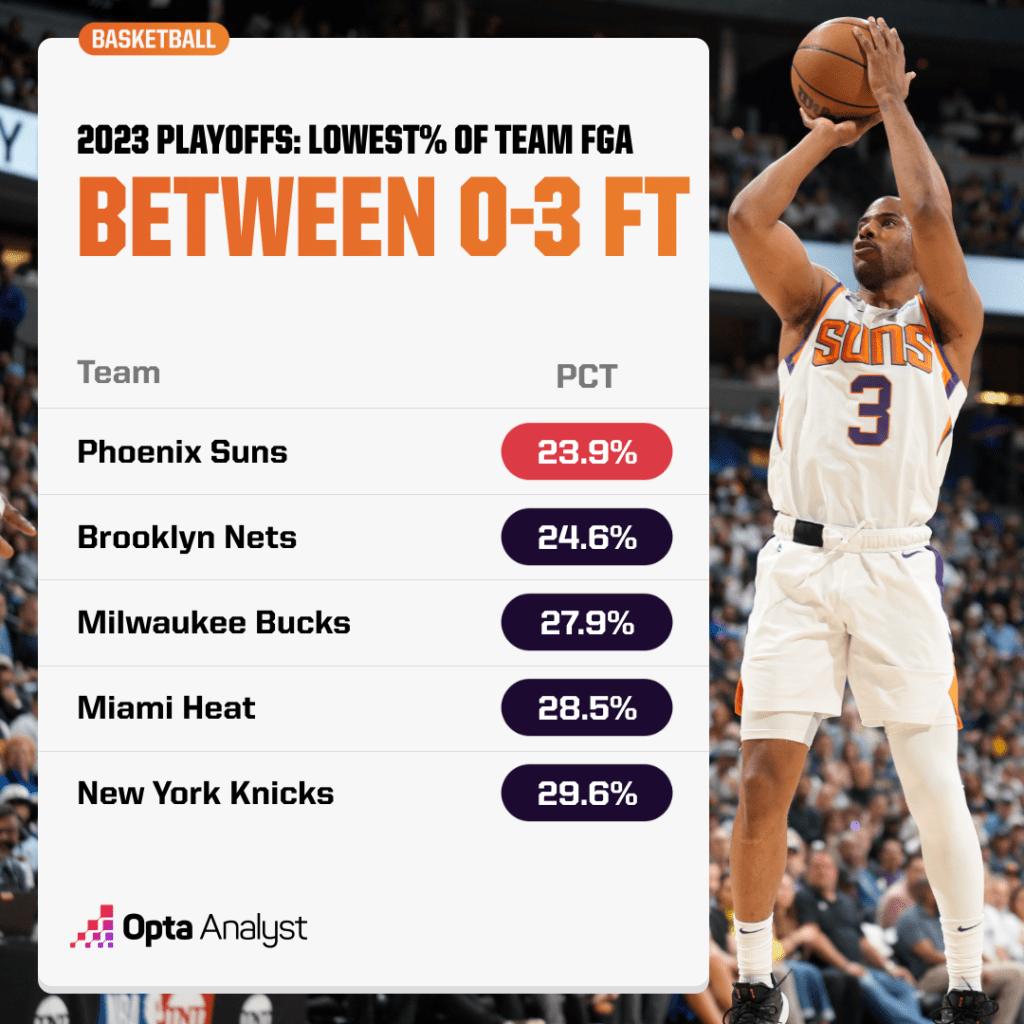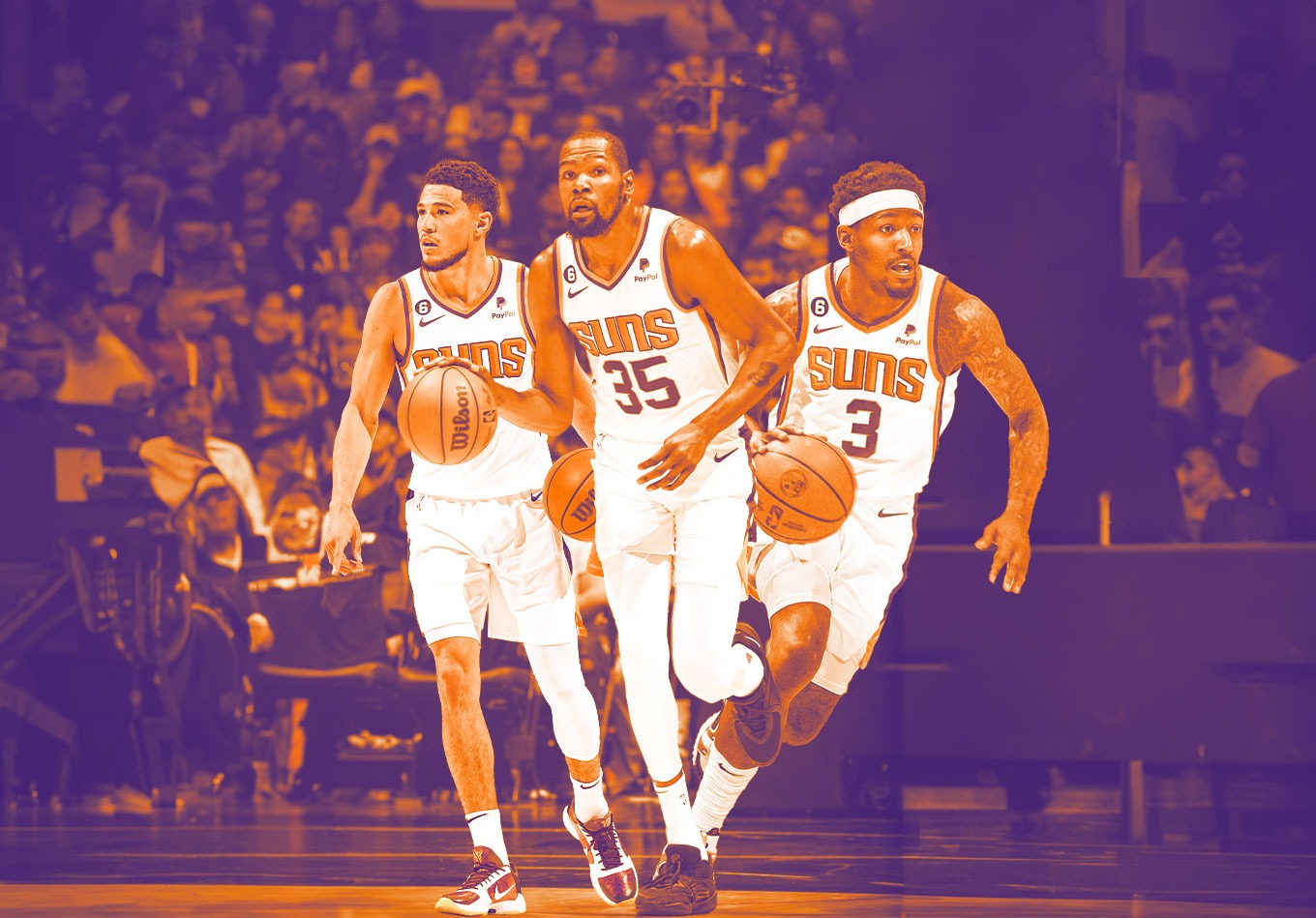It hasn’t even been a week since the Denver Nuggets became NBA champions, and yet somehow, we already have our first massive move of the offseason.
After eleven seasons in the nation’s capital, Bradley Beal is now a member of the Phoenix Suns.
So did the Suns make the right call? How does this deal address the problems that led to their demise in the Western Conference semifinals?
And should we be considering Phoenix as the favorite to win the NBA title next season?
What This Trade Really Means
Some folks will cite Beal’s age, injury history, or monster contract as cause for concern. However, we need not forget this deal really is at the end of the day.
The Suns are replacing Chris Paul (a 38-year-old point guard they were going to waive anyways), Landry Shamet (a good, but not great spacer), and a couple of miscellaneous second-round picks with Beal – a three-time All-Star who hasn’t even turned 30 yet.
In a vacuum, Beal will be tasked with a similar set of responsibilities as Paul was last season after the trade deadline. That means he’ll need to provide spacing for Devin Booker and Kevin Durant to operate, shoulder some creation burden so the aforementioned duo can profit off the ball, buoy lineups without one/both of them on the bench, and make sure he does just enough not to get burned on defense.
Starting in reverse order of that list, even with Paul’s wealth of knowledge and reputation as a splendid guard defender during his heyday, Beal is a clear upgrade over him on defense at this point in time.
Not only does he carry over eight years less of wear-and-tear on his body, but Beal is also just a bigger body than Paul. At 6-foot-4 with a 6-foot-8 wingspan, Beal is roughly 4 inches taller and longer than Paul. Opponents will still try to attack Beal, but isolating against someone of his stature is a much more strenuous endeavor than it is trying to do so against Paul.
On top of that, Beal has proven in the past that he can play heavy minutes on a great defensive team. In 2014-15, Beal’s third season, the Washington Wizards had the fifth-best defensive rating in the entire NBA, with Beal averaging 33.4 minutes across 63 appearances. So while he’s far from a good/great defender, he has the ability to ramp it up on that end when necessary.
As for his ability to keep the Suns humming when Booker and/or Durant are on the bench, look no further than his body of work from last season. Outside of Beal, the Wizards’ heavy hitters on offense – Kristaps Porziņģis, Kyle Kuzma, and Corey Kispert – were more of play-finishers than on-ball creators. This meant that Beal was practically the only legitimate on-ball initiator on the team.
Yet, despite this scarcity of creation around him, Beal was able to average 23.2 points and 5.4 assists on 59.3% true shooting (+1.2% better than the league average). And when he was on the floor, the Wizards (a team that finished 22nd in our adjusted offensive rating metric) posted a 116.6 offensive rating. For reference, if the Wizards performed at that rate all year, they’d have the sixth-best offense in the league.*
(*Sidebar: You can cite a statistic like that for a lot of teams when their best offensive player is on the floor. This doesn’t prove that Beal could be the best offensive player on an elite offense, but it does show that Beal is capable of being a No. 1 option in meaningful spurts.)
And the same reasons why Beal can be trusted to be a No. 1/No. 2 option while Booker/Durant are on the bench are the same reasons why we should believe that he can (at times) act as the setup artist when they’re together on the court.
He’s not the on-ball playmaker that Paul is (they don’t call you ‘The Point God’ for nothing), but Beal’s last few seasons as a lone star in Washington have groomed him into a capable pick-and-roll orchestrator. Since John Wall’s last game with the Wizards in 2018-19, Beal has posted a pick-and-roll ball handler efficiency in the 67th percentile or higher in three of his last four seasons (per NBA.com)
That just leaves us with the spacing component. Even in his elder years, Paul is a better pure shooter than Beal. In the last three seasons, Paul is averaging 45% on wide-open 3s while Beal is averaging just 41%.
However, the gap between them in this regard isn’t that significant at this point in time, and there is also a lot more to spacing than just being able to shoot. Great spacers are the ones who can create space with their off-ball gravity, and take advantage of space when the defense gives it to them.
Grandfather Paul is very stationary when the ball isn’t in his hands, and because of this, the Nuggets (and Los Angeles Clippers) would often help off of him in order to pack the paint. Like this:
Yes, Paul could theoretically burn the defense for doing this by hitting catch-and-shoot 3s. But given how rooted he is to that part of the floor, the defense trusts its ability to recover back to him and offer an adequate contest to his shot.
It isn’t that easy with someone like Beal. He’s the antithesis of Paul when it comes to off-ball movement. If you sag off of him like that, he might hit you with a back cut (69th percentile in efficiency). And if he didn’t do that and you managed to recover back to him, he could put the ball on the deck and aggressively drive that closeout with his Flash-like first step.
This all says nothing of his ability to attack off screens, curl cuts, pindowns, and handoffs (83rd percentile). Hopefully, they let Reggie Miller call a ton of Suns’ games next year because if they do, he’s going to get the chance to see a lot of his old self in Beal.
Along with his dynamic off-ball movement, Beal also adds some much-needed rim pressure to the offensive palate.
In the playoffs, the Suns had the lowest percentage of shot attempts between 0-3 feet (23.9%) from the rim of any of the 16 teams that participated. Paul didn’t do much to help the situation either, as only 11.0% of his shots came from this area.

Meanwhile, Beal’s appetite for the rim is almost as insatiable as his desire for off-ball movement. For his career, 27.5% of his shot diet comes from shots between 0 and 3 feet of the rim.
That’s higher than the career marks of Paul (16.5%), Booker (23.3%), and Durant (21.9%).
Every Team Has Weaknesses
Outside of the criticisms of Beal, there is some concern about the team-wide vulnerabilities that this iteration of the Suns is now plagued with. Namely, that team has massive questions regarding its defense and depth and has scarce resources available to address these issues.
But here’s the thing: almost every team ever assembled has some sort of weaknesses that other teams can try to exploit. Winning in sports isn’t about building a perfect team. Winning in sports is about building a team that can adequately mask its weaknesses and lean on its strengths to do the rest (see: the 2022-23 Nuggets).
In this case, the Suns’ weaknesses are no different than they were before the Beal trade. The only difference is that now their strengths are even more pronounced. Now they are even more of an offensive juggernaut than they were before (that’s a scary thing to think about). And as we’ve learned from studying NBA history, you can make a deep playoff run (even win an NBA title) by hanging your hat on an elite offense.
With that said, the Suns still have some things they need to sort out this offseason.
They need to figure out what their future is with Deandre Ayton. If they decide to trade him, they need to figure out how they can extract the most value possible from him (to try and resolve some of the defense/depth questions). And no matter what, they desperately need to hit a couple of home runs on their veteran minimum signings.
By no means did the Suns clinch the 2023-24 NBA title with their trade for Beal. But they are a lot closer to accomplishing that goal now that they have him on their roster.
Enjoy this? Follow us on Twitter.
